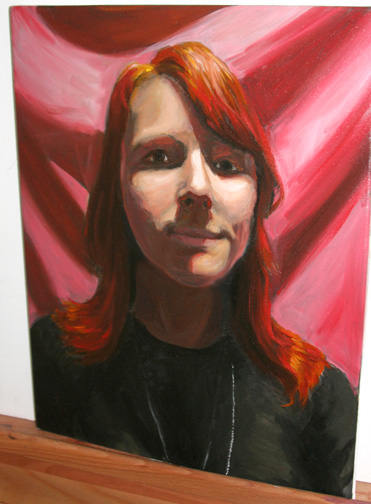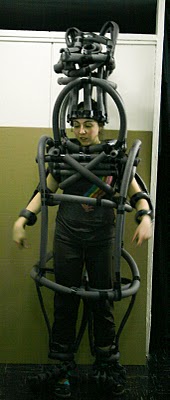Interview:Cynthia 12/22/11 Cynthia is featured in Portrait of a Girl and Her Art on pages 22-24 & in the “Portraits” gallery.
 “Self Portrait” by Cynthia 2006
“Self Portrait” by Cynthia 2006
Elena: Can you catch us up on what you’ve been up to since your feature in Portrait of a Girl?
Cynthia: I believe I was 16ish when I was in Portrait of a Girl. Since then, I discovered science and went to Oberlin College where I majored in Biology. I graduated this past May, and I’m currently doing research on brains in Florida. However, I’m slowly discovering that my creative side is pushing me towards writing about science to a general audience rather than doing laboratory research. I’ve started my own blog, called Notes of Ranvier, and am working on my writing skills (and doodling a lot in the margins of my notebooks!)
Elena:Where has art overlapped with your other passions?
Cynthia I would say that the creative energy I’ve gotten from art has helped me to understand, and then explain, concepts in science. If you think of evolution as a tinkerer (as one of my professors put it), then you can see how creative solutions have been made with parts that already exist. Did you know that the bones in your hands are very similar and are in fact coded by the same genes as the bones in a whale’s fin? We’re all more alike than we think, but it’s amazing to see the creative ways that evolution has made us each unique, as well.
Elena: Who are your favorite visual artists and or genre?
Cynthia: I’m pretty old school when it comes to art. My favorite time periods in art history are the Hellenistic period in Greece, the Renaissance and Baroque periods. More recent movements that I’ve gotten interested in are Art Deco, Art Nouveau, and Dadaism. (Take art history, kids, it’s super fun!) As for specific visual artists that I like, it’s hard to say. I’m bad with names, for one, and it’s also hard to choose a favorite. I guess I like Rembrandt, especially for his chiaroscuro technique! He wasn’t afraid to get dark in his paintings, and I think they have so much character because of it!
Elena: Anything you would like to say to young artists?
Cynthia: Keep at it! Keep drawing, painting, sculpting, taking pictures, whatever it is you do. Expose yourself to lots of different kinds of art, figure out what you like and what you don’t like, and why. We live in an age where creative work is easily accessible, so take advantage of it! Hopefully the work of others will inspire you to try new things, improve your skills, and exercise your creativity! But most importantly, keep in touch with yourself. Make sure that whatever you do in art, you are doing it for yourself! And of course, practice, practice, practice!
Cynthia’s featured piece in Portrait of a Girl and Her Art. “Cathedral” oil on canvas 2006
————————————————————————————————————————————-
Interview: Jonathan. 9/23/11
 Self Portrait-acrylic and tissue
Self Portrait-acrylic and tissue
Jonathan is an extremely busy and dedicated high school student. He is also a very talented tennis player, but makes time to create visual art.
Elena:What role does making art play in your life?
Jon:It gets me away from (the demands of) school and tennis. It’s something I can do that relaxes me.
Elena: Do you prefer to work in any particular medium?
Jon:I like sticking to pencil on paper. That’s what I work with the most.
Elena:What is it (about your artwork) that you most want to share?
Jon:I like talking about the ideas in my work.
Elena:What sort of tips do you have for a young artist?
Jon:Draw as much as possible.
 Scholastic silver medal winner -graphite
Scholastic silver medal winner -graphite Linoleum Block Print
Linoleum Block Print
————————————————————————————————————————————-
Interview: Julian 9/16/2011 Part 1 
Elena: At what age do you feel you began drawing in earnest?
Julian:Hard to remember, four?
Elena:What did you draw?
Julian:I have the drawings;characters, animals, middle eastern architecture, speculation about different cultures and ethnographic features of imaginary places. I drew anything that offered an intermediary between me and the world.
Elena:What kind of work do you do today?
Julian:Drawing is my native state-when it gets complicated it becomes painting. I’m still trying to navigate that transition, adding color and texture. Every time I think I’m ready to add a new element, I’m really not, so I go back to basics and I feel that painting has brought something to my drawings and the drawings become better than they were.
Elena:What inspires form in your drawings?
I sometimes start by simply allowing my ideas to accrue. The resulting visual effect is often that of a chaotic mountain. In my more successful drawings, I mentally whittle away what is unnecessary and leave only a select cross section of the mountain. This cross section often appears without a background– like an imaginary sculpture. I feel that sculpture is an apt metaphor for the process that I use, although I work in a two dimensional medium. While I often try to describe an imaginary sculpture using values and shading, I also seek out the ambiguities of pure line, a feature unique to the concept of drawing. The friction between these two ways of thinking adds mystery to the process and to the interpretation.
These drawings often stand alone like sculptures, but they are fundamentally drawings.
*Full disclosure:Julian is Elena’s son.----------------------------------------------------------------------------------------------- Interview 1:Leah is featured in Portrait of a Girl and Her Art on page 43 and page 70.
8/5/2011
Leah was instrumental in literally putting “Portrait of a Girl” together. She helped write, design and layout the pages, so it’s natural to pick Leah for the first blog I am
Elena:Why did you want to pursue a Master’s degree?
Leah:I have an undergraduate degree in illustration. I chose that major because I am compelled to draw, and illustration satisfied the drawing and experimental component of exploring quirky creatures and people in my work. I decided to go to graduate school to take the quirky creatures and people to the next level and create them in three dimensions. By the time I got to the end of my undergrad work in art school, I felt I had just gotten my feet wet with the 3-D work. I decided it was important to try to find guided exploration in the 3-D realm and that became puppetry.
Elena: What is your definition of puppetry?
Leah: I’ve come to realize that my definition of puppetry is less the performance aspect but more the craftsmanship of building puppets. 
Elena: You would rather create the creatures and leave the performance to others?
Leah:I’m not one hundred percent, sure yet what I’ll want to do in the end, but things that I’m currently exploring are stop motion animation, special effects, character design and development, sculpture, and 3-D illustration. Once you really start paying attention to how much “puppetry” is used in the art world, you can see just how much you can do in the field.
Elena: Who are your heros of 3-D?
Leah:I love the Brother Quay, Jan Svankmajer, David Michael Friend, the early work of Tim Burton, Brian Froud‘s work with Jim Henson, Red Nose illustration studio, Neil Gaiman and Dave McKean, and Ralph Steadman just to name a few:)
Elena: What would you like to leave us with?
Leah: I find that things are most interesting when they are imperfect in life and in art, because you have to discover the beauty in them or define the beauty for yourself. Beauty does not have to be beautiful. It can be grotesque or grungy. In puppetry, this can be challenging because there is a desire for anthropomorphic qualities, but human movement is not always achievable nor desired. You have to make specific decisions; should the creature be real, representational? It boils down to aesthetic style- perception, or how you would like the audience to perceive what they are viewing. An example is Sesame Street where the puppets simply bop around and a marionette that moves as close as possible to how a real human or creature moves. 
Elena:Any advice for young artists?
Leah: Don’t be afraid to try a million materials. Put you brain in your hands and let your hands do the thinking.
http://leahno.blogspot.com ———————————————————————————————————————————————– ————————————————————————————————————————————





wonderful!
she is wonderful isn’t she
Amazing!